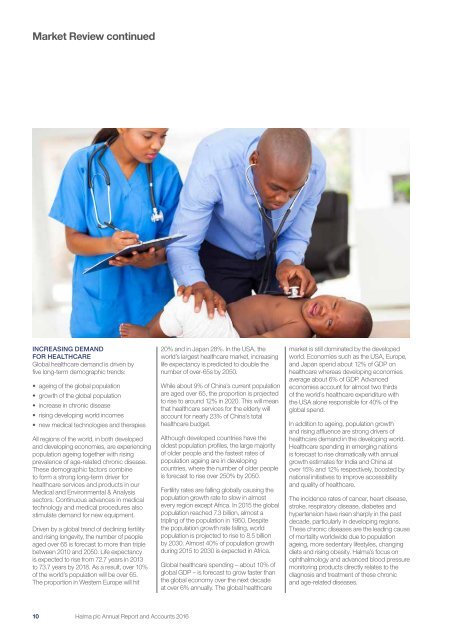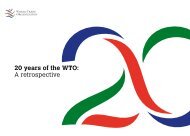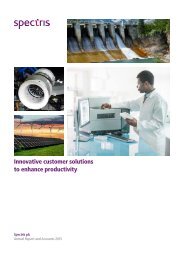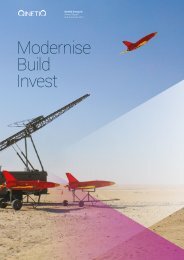Create successful ePaper yourself
Turn your PDF publications into a flip-book with our unique Google optimized e-Paper software.
Market Review continued<br />
INCREASING DEMAND<br />
FOR HEALTHCARE<br />
Global healthcare demand is driven by<br />
five long-term demographic trends:<br />
• ageing of the global population<br />
• growth of the global population<br />
• increase in chronic disease<br />
• rising developing world incomes<br />
• new medical technologies and therapies<br />
All regions of the world, in both developed<br />
and developing economies, are experiencing<br />
population ageing together with rising<br />
prevalence of age-related chronic disease.<br />
These demographic factors combine<br />
to form a strong long-term driver for<br />
healthcare services and products in our<br />
Medical and Environmental & Analysis<br />
sectors. Continuous advances in medical<br />
technology and medical procedures also<br />
stimulate demand for new equipment.<br />
Driven by a global trend of declining fertility<br />
and rising longevity, the number of people<br />
aged over 65 is forecast to more than triple<br />
between 2010 and 2050. Life expectancy<br />
is expected to rise from 72.7 years in 2013<br />
to 73.7 years by 2018. As a result, over 10%<br />
of the world’s population will be over 65.<br />
The proportion in Western Europe will hit<br />
20% and in Japan 28%. In the USA, the<br />
world’s largest healthcare market, increasing<br />
life expectancy is predicted to double the<br />
number of over-65s by 2050.<br />
While about 9% of China’s current population<br />
are aged over 65, the proportion is projected<br />
to rise to around 12% in 2020. This will mean<br />
that healthcare services for the elderly will<br />
account for nearly 23% of China’s total<br />
healthcare budget.<br />
Although developed countries have the<br />
oldest population profiles, the large majority<br />
of older people and the fastest rates of<br />
population ageing are in developing<br />
countries, where the number of older people<br />
is forecast to rise over 250% by 2050.<br />
Fertility rates are falling globally causing the<br />
population growth rate to slow in almost<br />
every region except Africa. In 2015 the global<br />
population reached 7.3 billion, almost a<br />
tripling of the population in 1950. Despite<br />
the population growth rate falling, world<br />
population is projected to rise to 8.5 billion<br />
by 2030. Almost 40% of population growth<br />
during 2015 to 2030 is expected in Africa.<br />
Global healthcare spending – about 10% of<br />
global GDP – is forecast to grow faster than<br />
the global economy over the next decade<br />
at over 6% annually. The global healthcare<br />
market is still dominated by the developed<br />
world. Economies such as the USA, Europe,<br />
and Japan spend about 12% of GDP on<br />
healthcare whereas developing economies<br />
average about 6% of GDP. Advanced<br />
economies account for almost two thirds<br />
of the world’s healthcare expenditure with<br />
the USA alone responsible for 40% of the<br />
global spend.<br />
In addition to ageing, population growth<br />
and rising affluence are strong drivers of<br />
healthcare demand in the developing world.<br />
Healthcare spending in emerging nations<br />
is forecast to rise dramatically with annual<br />
growth estimates for India and China at<br />
over 15% and 12% respectively, boosted by<br />
national initiatives to improve accessibility<br />
and quality of healthcare.<br />
The incidence rates of cancer, heart disease,<br />
stroke, respiratory disease, diabetes and<br />
hypertension have risen sharply in the past<br />
decade, particularly in developing regions.<br />
These chronic diseases are the leading cause<br />
of mortality worldwide due to population<br />
ageing, more sedentary lifestyles, changing<br />
diets and rising obesity. <strong>Halma</strong>’s focus on<br />
ophthalmology and advanced blood pressure<br />
monitoring products directly relates to the<br />
diagnosis and treatment of these chronic<br />
and age-related diseases.<br />
10 <strong>Halma</strong> plc Annual Report and Accounts <strong>2016</strong>

















